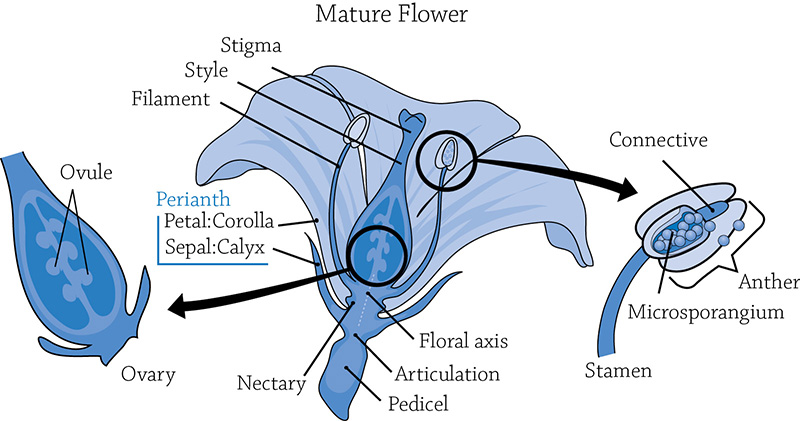Must Know High School Biology - Kellie Ploeger Cox 2019
PART FIVE Forms of Life
Plant Reproduction
MUST ![]() KNOW
KNOW
![]() Flowering plants’ evolutionary success is a result of double fertilization.
Flowering plants’ evolutionary success is a result of double fertilization.
![]() Double fertilization refers to one sperm fertilizing the egg (forming the embryo) and the other sperm fertilizing the two polar nuclei (forming the endosperm).
Double fertilization refers to one sperm fertilizing the egg (forming the embryo) and the other sperm fertilizing the two polar nuclei (forming the endosperm).
Plants create a lot of offspring. They have to, considering the low odds of their seeds finding conditions conducive to germination and seedling survival. The simpler plants such as moss rely on water to help their flagellated sperm swim to a neighboring moss plant’s egg. Clearly, little moss sperms cannot swim long distances in order to propagate the species. This is why a patch of moss grows slowly by spreading outward; only nearby eggs can be fertilized by neighboring sperm.
As plants became more advanced, they became better adapted for sending their progeny farther away and this helps them survive the dangerous and dry conditions that may await them. The flowering plants have evolved the most clever means to protect their embryos for the dangerous journey to unclaimed patches of soil. Our must know idea for this chapter is that flowering plants’ success is rooted (pun intended) in a reproductive mechanism called double fertilization.
Although many plants can clone themselves, it behooves any species to mix up their genetics in order to create variation in the population. Plant sex—just like animal sex—involves the fusion of two gametes (egg and sperm) to create a new organism. All plants, from the primitive moss to the fancy flowering plants, rely on eggs and sperm to create an embryo. Types of plants differ, however, in how much protection they provide for this developing embryo. In order for the embryo to survive, it must avoid desiccation (water loss) and live long enough to take root and grow in the soil.
Flowering plants have these awesome seeds that are brilliant adaptations intended to protect the embryo from the dangers of the environments. A seed, at its most basic, is temporary housing for a plant baby. The flowering plants take it one step farther and provide a food source (endosperm) inside the house (seed coat) for the baby (plant embryo). But I am getting ahead of myself—that’s the end of the double-fertilization story. Let’s first consider how it all began in an unfertilized flower.

Flower anatomy
Author: Mariana Ruiz LadyofHats. https://commons.wikimedia.org/wiki/File:Mature_flower_diagram.svg
A flower is the reproductive organ of a plant. A flower is categorized as a “perfect” flower if it has both the sperm-producing anthers and the egg-containing ovary.
![]()
IRL
Many flowers are called “imperfect” flowers because they contain either the ovary or the anther (not both). An imperfect flower cannot self-fertilize.
Pollen grains are produced in the anthers, and each mature pollen grain contains two sperm and a third cell called a tube nucleus. A pollen grain will catch the wind (or catch a ride on an animal) and find its way over to the sticky stigma at the top of the style. Once it lands on the stigma, the tube nucleus will grow into a tube that tunnels its way down the style, providing a pathway for the two sperm. Once the sperm reach the ovary, one will fertilize an egg cell that is awaiting inside each ovule. Here is when our must know concept of double fertilization comes into play! There were two sperm traveling down the pollen tube, right? One obviously has to fertilize the egg to produce an embryo. The other sperm fertilizes these other two cells called polar nuclei that are waiting in the ovule alongside the egg. This forms something called endosperm, which is like a packed lunch for the growing embryo. And since two polar nuclei were fertilized by a sperm, that creates a cell with three sets of chromosomes! That’s so weird! Sperm and eggs have one set of chromosomes (haploid), an embryo has two sets of chromosomes (diploid), and this endosperm stuff has three sets (triploid)!

Ta-da! Two sperm, double fertilization, and an embryo (and its food) are formed! Now a cascade of developmental changes are occurring in the flower, starting with the petals falling off (they’re no longer needed to attract pollinators). The embryo and the endosperm reside within the ovule, which eventually develops into the seed coat (protection for the embryo). The ovary will develop into the fruit (which animals eat and poop out the seeds somewhere else, helping to dispense the embryos).
![]()
The example I am providing is of a perfect flower with the traditional development of seeds and fruits. Please be aware that there are many exceptions to this scenario and the different ways fruits can develop is fascinating and varied. To get the true, full story, you need to immerse yourself in a botany class.
REVIEW QUESTIONS
1. What defines a flower as “perfect”?
2. In a flower, the _______________ produces the _______________, each of which carries _______________.
3. Fill in the following table:

4. Once fertilization occurs, the ovary develops into _______________, and the ovule develops into the _______________ (protecting the embryo). Since the embryo is stuck inside a protective coating, it needs a packed lunch to keep it alive until the embryo grows into a photosynthesizing plant; this food source is the _______________.
5. What flower type cannot self-fertilize, and why?
6. Pollination is when a pollen grain lands on the _______________. Fertilization is when the egg in the _______________ is fertilized by one of the two sperm that travels down the _______________ through the tube created by the third cell in the pollen grain, called a _______________. The second sperm will fertilize the _______________, turning into food for the embryo, called _______________.
7. For a typical flower, list these structures in order from outermost layer to innermost layer: ovule, egg, ovary, petals.
8. What is the benefit of an ovary developing into fruit?
